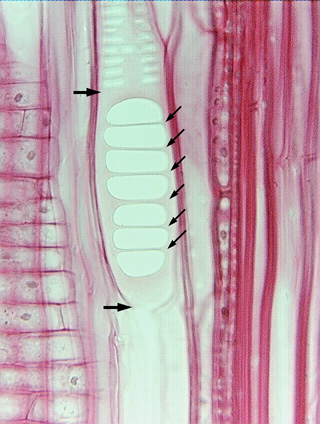 Fig.
7.3-7.
Longitudinal section of wood of magnolia (Magnolia tripetala). This section
contains a compound
perforation plate in face view. The seven large white ovals are the
actual perforations, separated from each other by six bars of perforation plate
wall material that was not digested away by the cells as they finished their
differentiation. Because the perforations are separated by parallel bars, this
is a scalariform
perforation plate. The region between the two large horizontal arrows
is the full perforation plate; although it consists of secondary wall material,
it has taken up very little stain and is unusually pale, not as dark red as most
other walls present here. Just above the perforation plate, you can see that the
vessel elements have broad pits -- almost wide enough to say they are
scalariform, a bit too wide to call them circular. Each has a white center
surrounded by a pale light gray rim: the white is the pit aperture, the gray is
the pit border (where the secondary wall has arched up away from the primary
wall, creating the pit chamber). The pale pink between each pit is the area
where the secondary wall is attached to the primary wall.
Fig.
7.3-7.
Longitudinal section of wood of magnolia (Magnolia tripetala). This section
contains a compound
perforation plate in face view. The seven large white ovals are the
actual perforations, separated from each other by six bars of perforation plate
wall material that was not digested away by the cells as they finished their
differentiation. Because the perforations are separated by parallel bars, this
is a scalariform
perforation plate. The region between the two large horizontal arrows
is the full perforation plate; although it consists of secondary wall material,
it has taken up very little stain and is unusually pale, not as dark red as most
other walls present here. Just above the perforation plate, you can see that the
vessel elements have broad pits -- almost wide enough to say they are
scalariform, a bit too wide to call them circular. Each has a white center
surrounded by a pale light gray rim: the white is the pit aperture, the gray is
the pit border (where the secondary wall has arched up away from the primary
wall, creating the pit chamber). The pale pink between each pit is the area
where the secondary wall is attached to the primary wall.